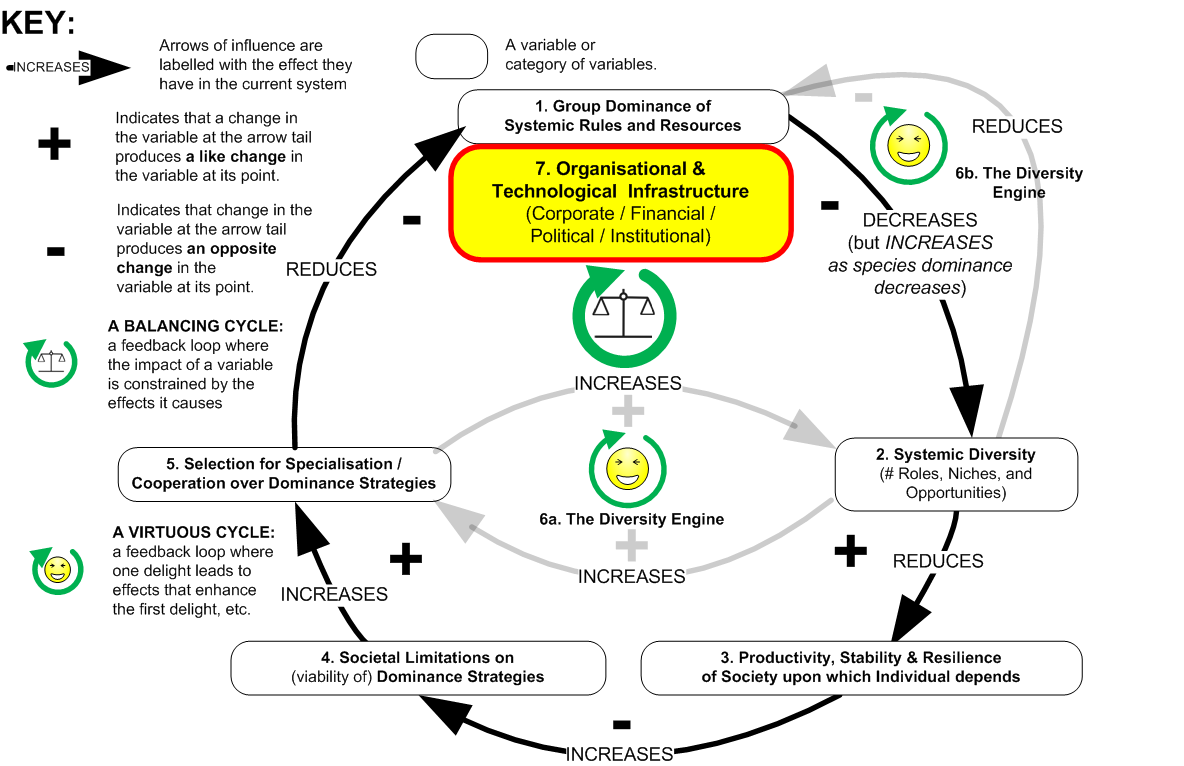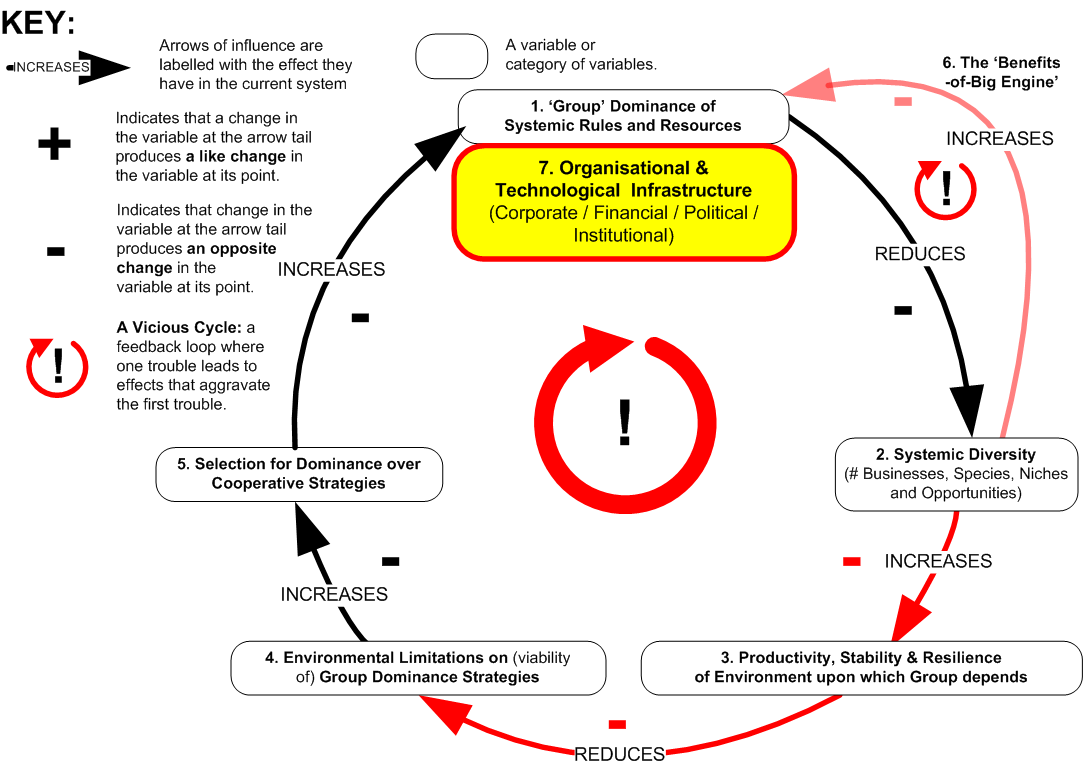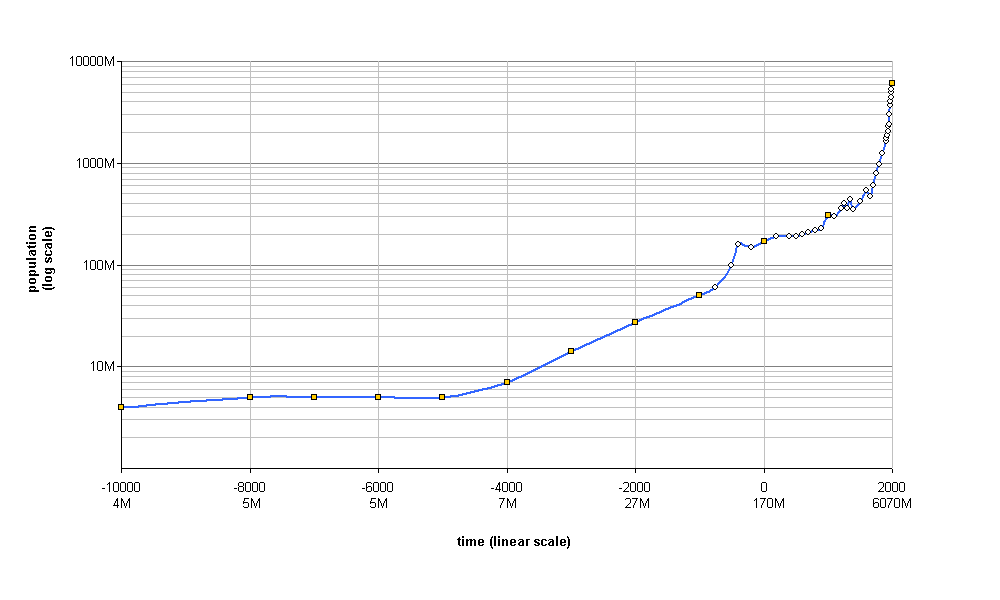Why Corporate Regulation is a Socioenvironmental Necessity. Part 5 of 5: How do We Create a Diverse and Stable Economic System?
Welcome to the belated final installment of our five part analysis. We have been working towards the title’s conclusion by seeking an answer to the following question.
What difference between natural / social, and economic, systems causes one to tend towards diversity and stability, and the other, uniformity and instability?
In installments 1, 2 and 3, we proposed that in natural / social systems a species or ‘group’ seeking total domination of their environment are constrained and, ultimately, destroyed by the impoverishing and destabilising effects of their actions on the systems upon which their own survival depends, thus leaving the arena open for dynamics that promote diversity and long-term stability (see previous installments if you need an explanation of the model below).
In installment 4 we suggested that the current economic system displays a reverse trend towards uniformity and instability because it allows the small ‘groups’ at the helms of corporations to gain increasing wealth and power from disintegrating social / natural systems without ever personally experiencing the environmental backlash of their actions. (see installment 4 if you need an explanation of the model below).
 To clarify, this shouldn’t be taken as a demonisation of businessmen. Some individuals are naturally entrepreneurial, status-driven or materially-oriented, and the prosperity and order we have come to enjoy in recent centuries are largely indebted to their spirit and energy. Indeed, there are few among us that wouldn’t pass up a lottery win and the prestige, security and freedom it affords.
To clarify, this shouldn’t be taken as a demonisation of businessmen. Some individuals are naturally entrepreneurial, status-driven or materially-oriented, and the prosperity and order we have come to enjoy in recent centuries are largely indebted to their spirit and energy. Indeed, there are few among us that wouldn’t pass up a lottery win and the prestige, security and freedom it affords.
However, in the current era, unconstrained profit-and-power motivated vicious cycles represent a mortal threat to our freedom of choice, quality of life and, most urgently, our planet’s life systems. If the virtuous feedback mechanisms that promote diversity and stability in natural / social systems do not function naturally in the current economic system, then they they must be imposed artificially with due haste. But how?
First let’s summarise, in a nutshell, the problem to be resolved…
In the current economic system, dominant ‘groups’ are able to benefit from abusing the diversity and stability of socioenvironmental systems without ever experiencing negative feedback from their actions.
Although many possible interventions occurred to Arkadian whilst writing this series, a coherent regulatory model, which offered an unobjectionable, easy transition from the current economic system was not so easy to imagine (the reason why the final installment has been so long in coming!). Happily, a fully-formed (40yr old) solution presented itself recently in Chapter 19 of ‘Small is Beautiful’, courtesy of the genius of economist, E.F. Schumacher (pictured left).
The Schumacher Business Model, stated simply, rests on 2 systemic ‘tweaks’: (1) limiting the number of people a single corporate entity can employ and (2) introducing meaningful public ownership and accountability into business structure and practice.
(1) Legally restricting corporation size by number of employees. It would seem reasonable that a ceiling should be dictated chiefly by evidence regarding effective human group size (see Dunbar’s number), say between 80-200 persons. Growth beyond the upper limit, Schumacher suggests, should entail the formation of new independent corporate units, which may be linked by joint stock. These restrictions would enable each employee to ’embrace the idea of the business as a whole’ and the value of their role therein, but most importantly to the current argument, it would ensure that ‘the group (i.e. The Board)’ couldn’t claim ignorance of the details of their company activities and, thus, could reasonably be held personally accountable for abuses.
Furthermore, constraining size, particularly when the exploitation of natural / social resources is involved, is also more likely to physically ground a corporation in a local environment. Bringing ‘the group’ closer to their employees and the raw coal face of their realworld transactions is likely to increase their susceptibility and responsiveness to negative socioenvironmental feedback both internal and external to their organisation. It is also liable to curb the scale of impacts of which a single corporate vehicle is capable.
All very well, the cynics may cry, but what of the ‘groups’ with the thicker skins and thinner moral fibre?
(2) Public Ownership and Accountability. Schumacher advises we put an end to annual corporate taxation (a proposition not disagreeable to most businessmen!). In its place he proposes that for every share sold privately by a company, a further share is issued to the public. Thus, as owner of 50% of the company, we’d collectively receive half of any dividends if and when they are paid out to shareholders (he argues that when a company grows beyond a certain size it loses its ‘private and personal character’ and thus can be considered, in a sense, a public enterprise anyway).
 To avoid disruption, our public equity wouldn’t allow us any voting rights in everyday business decision-making. It would, however, entitle us to attend Board meetings as an observer and, if the actions of the business were deemed to run counter to the public or environmental interest, we could apply to a court to get dormant voting rights activated.
To avoid disruption, our public equity wouldn’t allow us any voting rights in everyday business decision-making. It would, however, entitle us to attend Board meetings as an observer and, if the actions of the business were deemed to run counter to the public or environmental interest, we could apply to a court to get dormant voting rights activated.
To exercise these corporate responsibilities, Schumacher proposes the creation of independent citizen bodies funded from local business dividends. These ‘Social Councils’ would be split into four equal parts: three would have their members nominated by local trade unions, professional, and environmental, organisations, with the final quarter being drawn randomly from local residents in the manner of jury service. Involvement in management processes would, of course, be bound by strict confidentiality agreements.
Schumacher’s model brings socioenvironmental feedback directly into the Board room both as a ‘possibility in the background’ and, when necessary, as a real, prevailing constraint.
It is Arkadian’s prediction that, over time, exposing the ‘groups’ at the corporate helm to these balancing dynamics would drive a new trend towards macroeconomic diversity and stability, and greater corporate responsibility for the integrity of the natural environment (by triggering the ‘Diversity Engine’, described in installments 1, 2 and 3). And to top it all, it would require minimal design and economic / legal restructuring because, in the main, the model utilises existing frameworks and practices.
To conclude, effective corporate regulation is not just a Utopian nice-t0-have. It took till 1960 for World Population to hit 3bn. It has grown by 1bn approximately every 12yrs since, probably hitting the 7bn mark earlier this year. There are more human beings to house and feed today than have ever lived before. Presently, we have just over 2 acres of workable land each, 4x less than a century ago, and this is shrinking each moment as corporate activities and climate change destroy the natural world, and population continues to skyrocket.
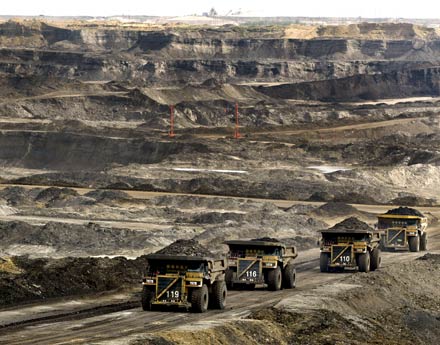 Resultant biodiversity loss, whilst often second-ranked in current ‘problem’ trends is, as we’ve established, probably the most dangerous of all due to its inscrutable relationship with macroenvironmental instability. With extinctions currently at 1000x the background base rate, and predicted to rise to 10,000x over this century, we are very rapidly, and very blindly, removing the Jenga pieces of our life systems, largely for the sake of the short-term wealth creation of the small ‘groups’ of the corporate elite. History is littered with exemplars of total societal and environmental meltdown as the result of human impact on vulnerable ecosystems: Easter Island, The Mayans, The Pueblo Culture of the South Western USA, the Norse Greenland and Iceland colonies to name but a few. If we repeat the same mistakes globally, we may not get a second chance.
Resultant biodiversity loss, whilst often second-ranked in current ‘problem’ trends is, as we’ve established, probably the most dangerous of all due to its inscrutable relationship with macroenvironmental instability. With extinctions currently at 1000x the background base rate, and predicted to rise to 10,000x over this century, we are very rapidly, and very blindly, removing the Jenga pieces of our life systems, largely for the sake of the short-term wealth creation of the small ‘groups’ of the corporate elite. History is littered with exemplars of total societal and environmental meltdown as the result of human impact on vulnerable ecosystems: Easter Island, The Mayans, The Pueblo Culture of the South Western USA, the Norse Greenland and Iceland colonies to name but a few. If we repeat the same mistakes globally, we may not get a second chance.
Considering the twin pincers of population growth and biodiversity loss, it is quite evident that socioenvironmental stability and sustainability are our most important objectives for the c21st, bar none. Our very survival depends on achieving them and success is contingent upon economic and environmental policy which is underpinned by the principle of diversity=stability=good. If variety is both the spice and source of life, then we must put democratic pressure upon Government and business to make the small tweaks to our economic system necessary for it to produce abundance by its own workings.
For a fascinating and vitally important lesson in the importance of preserving and promoting biodiversity, Arkadian cannot recommend the video below more highly. Essential viewing for all inhabitants of Planet Earth.
Why Corporate Regulation is a Socioenvironmental Necessity. Part 4 of 5: Why does the current Economic System tend towards Uniformity and Instability?
Welcome to the fourth and penultimate episode of a five-part Arkadian analysis which works towards the conclusion in the series title by seeking the answer to a simple question: –
“What difference between natural / social systems and the current economic system causes the former to tend towards diversity and stability, and the latter, uniformity and instability?”
In Weeks 1 and 2, we explored why ecosystems and ‘civilisations’ tend towards diversity and proposed virtuous dynamics (the ‘Diversity Engine’) that power increasingly fine-grained specialisation / cooperation, whilst inhibiting environmental dominance by particular species or social ‘groups’. Last Week, we looked at three examples at different ‘levels’ (social group, societal, global) which illustrated why overall systemic stability and resilience, and, thus, the common good, depends on a shared responsibility for productivity produced by this trend.
Today, we aim to get the crux of the issue at the heart of this series by investigating why the current global economic system behaves in the opposite way.
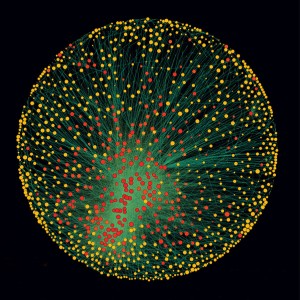 The last few decades have seen a dramatic global trend towards economic uniformity across most market sectors – most notably and worryingly, finance, media, food and agriculture, and manufacturing. A recent systems analysis by PLos One revealed that a network of 1318 companies directly represent a quarter of global operating revenues and, indirectly, via shareholdings in blue chips and manufacturing, a further 60%. Of these, a super-group of 147 companies, mostly financial institutions controls 40% of the total wealth in the system.
The last few decades have seen a dramatic global trend towards economic uniformity across most market sectors – most notably and worryingly, finance, media, food and agriculture, and manufacturing. A recent systems analysis by PLos One revealed that a network of 1318 companies directly represent a quarter of global operating revenues and, indirectly, via shareholdings in blue chips and manufacturing, a further 60%. Of these, a super-group of 147 companies, mostly financial institutions controls 40% of the total wealth in the system.
This homogeneity has also correlated with a spectacular increase in the scale and financial muscle of global corporations. A 2002 UNCTAD analysis, which used the sum of salaries and benefits, depreciation and amortization, and pre-tax income to compare firms with the GDP of countries, found that a third of the world’s 100 largest economic entities were transnational corporations. The biggest, Exxon, rivaled the economies of Chile or Pakistan; Philip Morris was on a par with Tunisia, Slovakia and Guatemala; and a more recent study research shows General Motors, DaimlerChrysler, Shell, and Sony to outsize Denmark, Poland, Venezuela, and Pakistan, respectively.
Many other corrosive trends have gone hand-in-hand with this expansion. According to statistics gathered by the New Economics Foundation, income inequality is now higher than at any other time in human history with the CEOs of the 365 biggest US companies earning over 500x that of the average employee. Corporate strategies to augment profits – outsourcing, temporary employment contracts, mechanisation and process efficiency – have eroded wages, job satisfaction and security, and human labour productivity, with the world’s biggest 200 transnationals now accounting for a third of world economic activity but employing less than 0.25% of the global workforce.
So what are the dynamics underpinning this pernicious trend? MODEL 3 of our analysis below proposes an answer (N.B. If you have trouble reading the text, click on the diagram to open it in a new browser tab and then refer back to the explanation here).
Whilst Model 3 involves more-or-less identical variables to the Models 1 (Ecosystems) and 2 (Civilisations) we explored in Weeks 1 and 2 respectively, there are several critical differences. Firstly, we broaden the definition of ‘diversity’ to include both socioeconomic and natural systems. Secondly, the term ‘group’ (which referred to political elites in Model 2) now refers specifically to the small alliance of people for whom a given corporation is a vehicle of wealth-creation: board executives, major shareholders, higher management and, to a lesser degree, senior employees, i.e. the people who don’t lose their jobs or bonuses during cutbacks.
 Thirdly, and most fundamentally, is a change in the polarity of the two arrows (coloured red) connecting variables (2), (3) and (4). Unlike dominant species in ecosystems and ruling elites in political systems, these ‘groups’,empowered by (7) policy and infrastructure that enable vast geographical reach, promote their self-interest and shield them against personal accountability for abuses, are able to reduce systemic diversity without their actions having corresponding negative effects on the stability and resilience of their own local environment.
Thirdly, and most fundamentally, is a change in the polarity of the two arrows (coloured red) connecting variables (2), (3) and (4). Unlike dominant species in ecosystems and ruling elites in political systems, these ‘groups’,empowered by (7) policy and infrastructure that enable vast geographical reach, promote their self-interest and shield them against personal accountability for abuses, are able to reduce systemic diversity without their actions having corresponding negative effects on the stability and resilience of their own local environment.
Indeed, (3) the greater the ‘group’s’ impact on diversity, the more prosperous and secure their personal environment becomes. Thus, in the current economic system, (1, 4, 5 and 6) the drive for dominance of rules and resources is invigorated by growing wealth, social mobility and political influence, unlike ecosystems and civilisations, where it was curtailed by its weakening and destabilising impact on the environment And so it turns: not a Balancing Loop, but a Vicious Circle: a feedback loop where one trouble leads to effects that aggravate the first trouble, and so on.
To exacerbate problems, the absence of limiting environmental feedback also reverses the dynamics of the ‘Diversity Engine’, turning it into its ominous alter ego: a Vicious Circle we’ve named the (6) ‘Benefits-of-Big Engine’.
Here, instead of a trend towards economic diversity facilitating healthy competition and new business opportunities, and making market domination progressively more difficult, a small group of dominant players is able to harness ever greater resources, economies-of-scale and mechanisms of influence (price, lobbying, political office, advertising, media, academia) to overcome existing competition and render future challengers increasingly futile and improbable.
Disturbingly, whilst in nature / society the weaknesses and instability resulting from systemic impoverishment ultimately defeat the dominant species and ruling groups responsible, thereby facilitating a new order, in the current economic system they increasingly further the interests of the corporate ‘groups’ that have caused them.
These giants can downsize, buyout or price-out smaller floundering competition, and their huge economic significance means that, even if things get really bad, national governments are likely to intervene rather than risk the impact of bankruptcy. As touched upon in Week 2, the crisis-stricken financial sector is a perfect example, where after the panic of insolvencies, public bailouts and recession, a run of mergers and buyouts gave birth to a more monolithic, powerful and fragile banking system than ever before.
 Possibly the darkest characteristic of ‘The Benefits of Big’, however, is that the larger and more ubiquitous these corporate vehicles become, and the more competitively priced their products and services, the more difficult it becomes for us to avoid participating in their expansionary activities.
Possibly the darkest characteristic of ‘The Benefits of Big’, however, is that the larger and more ubiquitous these corporate vehicles become, and the more competitively priced their products and services, the more difficult it becomes for us to avoid participating in their expansionary activities.
Thus, as customers, suppliers and employees, we all unknowingly or unwillingly, become complicit in dynamics that increasingly impoverish and endanger the systems upon which we depend.
In short, in the current economic system there appears to be no constraint on the wealth-creation of ‘groups’ at the helms of corporations other than a total socioenvironmental meltdown.
Happily, there is much we can do to change this. We hope you’ll join us next Friday for our final installment, when we shall use what we’ve learned from the virtuous ‘Diversity Engine’ of ecosystems / civilisations to propose interventions that could reverse the vicious ‘Benefits of Big Engine’ and create a self-sustaining economic system that benefits people and planet.
Recent Posts
- Seeding a Viable Economic Alternative. Pt 3: Placing Mother Nature First
- Seeding a Viable Economic Alternative. Pt 4: Ego-as-Process
- Charlie Hebdo and the Immorality Loop
- My Top 20 Waterfalls Pt3 (S America: #2-1)
- My Top 20 Waterfalls Pt2 (S America: #7-3)
- My Top 20 Waterfalls Pt1 (Africa, Asia, Europe & N America)
- Positive Change using Biological Principles, Pt 4: Principles in Action
- Positive Change using Biological Principles Pt 3: Freedom from the Community Principle
- Positive Change using Biological Principles Pt 2: The missing Community Principle
- Positive Change using Biological Principles, Pt 1: The Campaign Complex
- Seeding a Viable Economic Alternative. Pt 2: The Principal Themes (Outcomes of a Systems Workshop at Future Connections 2012)
- Seeding a Viable Economic Alternative. Pt 1: The Action Plan (Outcomes of a Systems Workshop at Future Connections 2012)
- What I Learned from Destroying the Universe
- Why Corporate Regulation is a Socioenvironmental Necessity. Part 5 of 5: How do We Create a Diverse and Stable Economic System?
- The Root of all Evil: how the UK Banking System is ruining everything and how easily we can fix it.
- What is Occupy? Collective insights from a ‘Whole Systems’ Session with Occupy followers
- Why Corporate Regulation is a Socioenvironmental Necessity. Part 4 of 5: Why does the current Economic System tend towards Uniformity and Instability?
- Why Corporate Regulation is a Socioenvironmental Necessity. Part 3 of 5: Why does A Diverse System = A Stable System?
- Why Corporate Regulation is a Socioenvironmental Necessity. Part 2 of 5: Why does (did) Civilisation tend towards Diversity and Stability?
- Why Corporate Regulation is a Socioenvironmental Necessity. Part 1 of 5: Why do Ecosystems tend towards Diversity and Stability?





